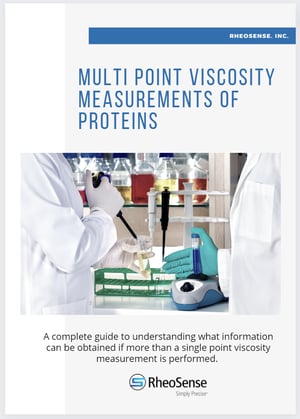Protein-based drugs are the fastest growing class of drugs for the treatment of many diseases in humans, ranging from cancer to Alzheimer’s disease.
Concentrated protein solutions are complex fluids containing proteins, but also surfactants, stabilizers, and salts. These components all interact with each other and can influence solution viscosity. The rheological behavior of protein solutions will reflect differences in protein size as well as the formation of complex structures or networks resulting from various types of molecular interactions. Viscosity measurements can be used to infer information about protein formulations and probe how formulation changes impact protein solutions.

Single point viscosity measurements of complex fluids can suffice for quality control or screening purposes if the shear rate is chosen carefully or if the formulation is confirmed Newtonian. However, it is advantageous to explore the shear rate dependence of protein solutions to understand solution stability, efficacy, and overall performance. Since rheological properties reflect protein formulation, protein-protein interactions, and the resulting microstructure or spatial arrangement of molecules, correlations between buffer composition and the molecular level behavior of the proteins can be made. A thorough viscosity analysis of protein formulations should include both shear rate and temperature variation. This data can be used for practical purposes such as performance prediction at any relevant temperature. It can also be utilized to investigate the component interactions and resulting microstructure.
Download our free eBook, "Multi Point Viscosity Measurements of Proteins", to learn more about common multi point viscosity measurements, what each measurement can teach you about your protein solutions, and why a thorough viscosity analysis of concentrated protein formulations should include both shear rate and temperature variation.

The long-term stability of pharmaceutical formulations containing proteins or antibodies is a continual concern. Concentrated protein formulations are dynamic, and Viscosity serves as an ideal indicator of stability since it is highly sensitive to changes in the individual proteins, protein-protein interactions, and the resulting microstructure.
Intrinsic viscosity is a reliable and sensitive indicator of a solute’s molecular interaction with a solvent, and can be used to determine the molecular properties of a sample, such as:
- Molecular weight and size
- Polymerization
- Interaction of molecules
- Degradation
- Branching structure
- Stability of molecules: aggregation, denaturation, or conformational changes of protein molecules
- Protein structure and melting temperatures
The key to accurately measuring intrinsic viscosity is repeatability. RheoSense VROC® powered viscometers offer exceptional repeatability (0.5% of reading), which ensures that you are able to quickly and easily obtain highly accurate (2%), reliable results using small samples.

RheoSense offers a variety of viscometers that measure viscosity under high-throughput capabilities under various shear rates. Your research and criteria is a uniquely tailored application. Contact us to speak with a rheology expert about which VROC instrument is right for you!
Written by: Eden Reid, Senior Marketing and Sales Operations



